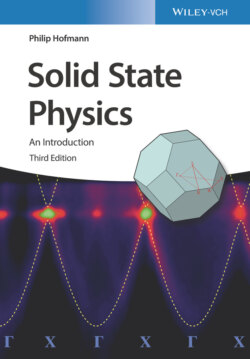Читать книгу Solid State Physics - Philip Hofmann - Страница 18
1.2.3 Structures of Covalently Bonded Solids
ОглавлениеIn covalent structures, the valence electrons of the atoms are not completely delocalized but shared between neighboring atoms, and bond lengths and directions are far more important than the packing density. Prominent examples are graphene, graphite, and diamond as displayed in Figure 1.7. Graphene is a single sheet of carbon atoms in a honeycomb lattice structure. It is a truly two‐dimensional solid with a number of remarkable properties – so remarkable, in fact, that their discovery has lead to the 2010 Nobel prize in physics being awarded to A. Geim and K. Novoselov. The carbon atoms in graphene are connected through a network of sp hybrid bonds enclosing angles of 120. The parent material of graphene is graphite, which consists of a stack of graphene sheets that are weakly bonded to each other. In fact, graphene can be isolated from graphite by peeling off flakes with a piece of scotch tape. In diamond, the carbon atoms form sp‐type bonds and each atom has four nearest neighbors in a tetrahedral configuration. Interestingly, the diamond structure can also be described as an fcc Bravais lattice with a basis of two atoms.
Figure 1.7 Structures for (a) graphene, (b) graphite, and (c) diamond. Bonds from sp and sp orbitals are displayed as solid lines.
The diamond structure is also found for Si and Ge. Many other isoelectronic materials (i.e. materials with the same total number of valence electrons), such as SiC, GaAs, or InP, also crystallize in a diamond‐like structure but with each element on a different fcc sublattice.
